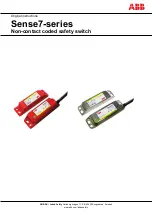
B-1909-1(0)
INSTRUCTION SHEET - HS1C Series
Solenoid Type Safety Switch
( 2 / 5 )
2016.08
Center Safety Switch
±1.0 mm
±1.0 mm
• Mounting tolerance of the actuator is 1.0mm from
the center of the actuator to up, down, right, and,
left.
• Make sure the actuator can be inserted into the
entry slot without any issue.
Actuator Mounting Tolerance
Recommended Screw Tightening Torque
For mounting the safety switch (M5 hexagon socket head cap screw)
*6
For moun ing the actuator (M6 hexagon socket head cap screw)
*6
For moun ing the lid (M4)
Connector (G1/2)
Plug for Unused Conduit Hole (G1/2)
Screw Terminal No.1 to 6 (M3)
Screw Terminal No.7,8 (M3.5)
Ground Terminal screw (M4)
Angle adjusting screw of HS9Z-A3
(M3 hexagon socket head cap screw)
Screw Tightening Torque
Name or Use
CAUTION
*6 When the torque is not enough to recommended screw tightening torque, make
sure that the screw do not become loose by using adhesive sealants etc. to
keep right opera ion and mounting positioning.
• The HS1C allows manual unlocking of the actuator to
precheck door operation before wiring or turning on power, as
well as for emergency use such as a power failure.
• Remove the screw from the side of the safety switch using the
wrench for mounting the lid. Push the lever inside the safety
switch towards the pilot light using a small screwdriver until the
actuator is unlocked. See the figure on the right.
Manual Unlocking
Screwdriver
4.5
~
5.5 N•m
4.5
~
5.5 N•m
1.1
~
1.3 N•m
2.7
~
3.3 N•m
1.8
~
2.2 N•m
0.4
~
0.6 N•m
0.9
~
1.1 N•m
0.9
~
1.1 N•m
0 8 N•m
• As shown below, the mounting reference position of the actuator inserted into the
safety switch is the actuator cover or stop film touches the safety switch ligh ly. (After
mounting the actuator, remove the actuator cover or stop film from the safety switch.)
Actuator Mounting Reference Position
HS9Z-A2
Actuator
HS9Z-A1
Actuator
Actuator
Cover
Safety
Switch
Door Stop
Door Stop
Actuator
Cover
Safety Switch
HS9Z-A3
Actuator
Stop film
Safety Switch
Note : During installation, ensure that there is no excess force applied between the
safety switch and actuator by installing a door stopper as shown in the image.
• Actuator can move 3.8mm (HS9Z-A1 and -A2) /
2.7mm (HS9Z-A3) from the mounting position
without affecting the contact operation.
• When closing the door (when actuator is
inserted into safety switch), the solenoid is
locked as the actuator has reached at approx.
6.4mm (HS9Z-A1 and -A2) / 5.3mm (HS9Z-A3)
to the moun ing reference position.
Devia ion of
actuator position
Deviation of
door position
≤ 3.8 / 2.7mm
+
*5 To ensure that the door locks correctly, install the actuator in a position that is
within 6.4 mm (HS9Z-A1 and -A2) / 5.3 mm (HS9Z-A3) of the standard
installation position. If the actuator is not in the correct position, the door will not
lock and there is a risk that an incorrect safety circuit may turn ON.
3.8mm
2.7mm
HS9Z-A1
and -A2
HS9Z-A3
*5
*5
Approx.
6.4mm
Approx.
5.3mm
HS9Z-A1
and -A2
HS9Z-A3
CAUTION
• Using the angle adjusting screw (M3 hexagon
socket head screw), the actuator angle can be
adjusted up to 20°.
• The larger the actuator angle, the smaller the appli-
cable radius of the door swing. After installing the
actuator, open the door. Then adjust the actuator
angle so that the actuator enters the entry slot of
the safety switch properly.
• After adjusting the actuator angle, apply loctite or the like on the adjusting screw to
prevent loosening.
Adjusting the Angle Adjustable Actuator (HS9Z-A3)
20°
Angle adjusting
screw
Installation
• Do not apply an excessive shock to the safety switch when
opening or closing the door. A shock to the safety switch
exceeding 1,000 m/s
2
may cause failure.
• Provide a door guide, and ensure that force is applied on the
safety switch only in the actuator insertion direction.
• Do not pull the actuator while it is locked. Also, regardless of
door types, do not use the safety switch as a door lock. Install
a separate lock as shown in item 3.
• When opening the safety switch lid to wire, open the lid 1 only.
(See the figure on the right.)Never remove other screws,
otherwise the safety switch may be damaged.
• The safety switch cover can be only removed or installed with
the special L-shaped key wrench supplied with the switch.
• Make sure to install the product in a place where it cannot be
damaged. Make sure to conduct a proper risk assessment
evaluation before using the product, and use a shield or a
cover to protect the product if need be.
• Solenoid has polarity. Be sure to wire correctly. Do not apply
voltage that exceed the rated voltage, otherwise the solenoid
will be burnt out.
• Avoid foreign objects such as dust, liquid, and oil from entering
the switch while connecting a conduit or wiring.
• Entry of foreign objects in the actuator entry slot may affect the mechanism of the
switch and cause a breakdown. If the operating atmosphere is contaminated, use a
protective cover to prevent the entry of foreign objects into the switch through the
actuator entry slots.
• Use only the designated actuator for the HS1C. Other actuators will cause a break-
down of the switch.
4
Precautions for Operation
1
Screw for manual
unlocking
Two actuator
entry slot
L-shaped wrench
attached to he
safety switch
Type: HS9Z-T1
WARNING
• Turn off the power to the safety switch before starting installation, removal, wiring,
maintenance, and inspection on the safety switch. Failure to turn power off may
cause electrical shocks or fire hazard.
• Use wires of a proper size to meet voltage and current requirements. Tighten the
terminal screws to a recommended tightening torque of 1.0N
・
m. Loose terminal
screws will cause unexpected heating and fire hazard during operation.
CAUTION
• Before manually unlocking the safety switch, make sure the machine has come to
a complete stop. Manual unlocking during operation may unlock the switch before
the machine stops, and the function of safety switch with solenoid is lost.
• After the unlocking operation, be sure to turn the screw to the original position for
safety.
CAUTION
• Regardress of door types, do not use the safety switch as a door stop. Install a
mechanical door stop at the end of the door to protect the safety switch against an
excessive force.
• Mount the actuator so that it will not hit the operator when the door is open,
o herwise injury may be caused.
• Pay attention to the management of spare actuator. Safety function of door inter-
lock switch will be lost in case the spare actuator is inserted into the interlock
switch. Ensure that the actuator is firmly fastened to the door (welding, rivet,
special screw) in the appropriate location, so that the actuator cannot be removed
easily.
• Do not cut or remodel the actuator, otherwise failure will occur.
• If multiple safety components are wired in series, the Performance Level to
ISO13849-1 will be reduced due to the restricted error detection under certain
circumstance.
• The insulation of the cable has to withstand environmental influences.
• The entire concept of the control system, in which the safety component is
integrated, must be validated to ISO13849-2.























